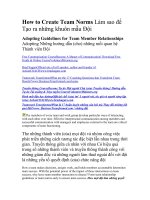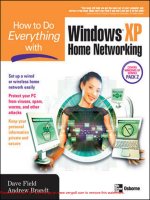Tài liệu How to Teach This Module pdf
Bạn đang xem bản rút gọn của tài liệu. Xem và tải ngay bản đầy đủ của tài liệu tại đây (676.7 KB, 16 trang )
Introduction
Contents
Introduction
1
Course Materials
2
Prerequisites
3
Course Outline
4
Microsoft Certified Professional Program
6
Facilities
9
Information in this document, including URL and other Internet Web site references, is subject to
change without notice. Unless otherwise noted, the example companies, organizations, products,
domain names, e-mail addresses, logos, people, places, and events depicted herein are fictitious,
and no association with any real company, organization, product, domain name, e-mail address,
logo, person, places or events is intended or should be inferred. Complying with all applicable
copyright laws is the responsibility of the user. Without limiting the rights under copyright, no part
of this document may be reproduced, stored in or introduced into a retrieval system, or transmitted
in any form or by any means (electronic, mechanical, photocopying, recording, or otherwise), or
for any purpose, without the express written permission of Microsoft Corporation.
Microsoft may have patents, patent applications, trademarks, copyrights, or other intellectual
property rights covering subject matter in this document. Except as expressly provided in any
written license agreement from Microsoft, the furnishing of this document does not give you any
license to these patents, trademarks, copyrights, or other intellectual property.
2001-2002 Microsoft Corporation. All rights reserved.
Microsoft, MS-DOS, Windows, Windows NT, Win32, Active Directory, ActiveX, BizTalk,
IntelliSense, JScript, MSDN, SQL Server, Visual Basic, Visual C#, Visual C++, Visual J#, Visual
Studio, and Windows Media are either registered trademarks or trademarks of Microsoft
Corporation in the U.S.A. and/or other countries.
The names of actual companies and products mentioned herein may be the trademarks of their
respective owners.
Introduction
Instructor Notes
Presentation:
30 Minutes
The Introduction module provides students with an overview of the course
content, materials, and logistics for Course 2389B, Programming with
ADO.NET.
Required materials
To teach this course, you need the following materials:
!
!
Preparation tasks
Delivery Guide
Trainer Materials compact disc
To prepare for this course, you must:
• Complete the Course Preparation Checklist that is included with the trainer
course materials.
iii
iv
Introduction
How to Teach This Module
This section contains information that will help you to teach this module.
Introduction
Welcome students to the course and introduce yourself. Provide a brief
overview of your technical background to establish credibility.
Ask students to introduce themselves and to describe their background, product
experience, and expectations of the course.
Record the expectations of students on a whiteboard or flip chart that you can
reference later in class.
Course materials
Tell students that everything they will need for this course is provided at their
desks.
Tell students to write their names on both sides of their name card.
Describe the contents of the student workbook and the Student Materials
compact disc.
Tell students where they can send comments and feedback on this course.
Demonstrate how to open the Web page that is provided on the Student
Materials compact disc by double-clicking Autorun.exe or Default.htm in the
StudentCD folder on the Trainer Materials compact disc.
Prerequisites
Describe the prerequisites for this course. This is an opportunity for you to
identify students who may not have the appropriate background or experience
to attend this course.
Course outline
Briefly describe each module and what students will learn. Be careful not to go
into too much detail because the course is introduced in detail in Module 1.
Explain how this course will meet students’ expectations by relating the
information that is covered in individual modules to their expectations.
Setup
Describe the classroom setup. Cover the following aspects of the classroom
setup:
!
Go over the location of course files. Prompt students to create a desktop
shortcut to their course files. If you performed a default installation of the
course files, the files will be installed in C:\Program Files\Msdntrain\2389.
!
Describe the lab file structure in terms of start files and solution files.
!
Tell students whether they have Internet access.
!
Describe the computer naming convention used in the classroom.
!
Describe whatever passwords are in place for the operating system and for
Microsoft® SQL Server™.
!
Read the required software list to the students. Distinguish between software
titles that are available through retail channels versus those that are freely
downloadable from the Web. Make sure that students understand what is
needed to reproduce the classroom environment.
Introduction
Microsoft Official
Curriculum
v
Explain the Microsoft Official Curriculum (MOC) program and present the list
of additional recommended courses.
Refer students to the Microsoft Official Curriculum Web page at
for information about curriculum
paths.
Microsoft Certified
Professional program
Inform students about the Microsoft Certified Professional (MCP) program, any
certification exams that are related to this course, and the various certification
options.
Facilities
Explain the class hours, extended building hours for labs, parking, restroom
location, meals, phones, message posting, and where smoking is or is not
allowed.
Let students know if your facility has Internet access that is available for them
to use during class breaks.
Also, make sure that the students are aware of the recycling program if one is
available.
Introduction
1
Introduction
!
Name
!
Company or Organization Affiliation
!
Title and Job Function
!
Job Responsibility
!
Development Experience
!
Experience with ADO, XML, and Related Technologies
!
Expectations for the Course
*****************************ILLEGAL FOR NON-TRAINER USE******************************
2
Introduction
Course Materials
!
Name Card
!
Student Workbook
!
Student Materials Compact Disc
!
Course Evaluation
*****************************ILLEGAL FOR NON-TRAINER USE******************************
The following materials are included with your kit:
!
Name card. Write your name on both sides of the name card.
!
Student workbook. The student workbook contains the material covered in
class, in addition to the hands-on lab exercises.
!
Student Materials compact disc. The Student Materials compact disc
contains the Web page that provides you with links to resources pertaining
to this course, including additional readings, review and lab answers, lab
files, multimedia presentations, and course-related Web sites.
Note To open the Web page, insert the Student Materials compact disc into
the CD-ROM drive, and then in the root directory of the compact disc,
double-click Autorun.exe or Default.htm.
!
Course evaluation. To provide feedback on the course, training facility, and
instructor, you will have the opportunity to complete an online evaluation
near the end of the course.
To provide additional comments or inquire about the Microsoft Certified
Professional program, send e-mail to
Introduction
3
Prerequisites
!
Database basic concepts
!
XML concepts and implementation
!
Microsoft Visual Basic .NET or Visual C# .NET
!
Microsoft Visual Studio .NET development environment
!
Distributed application architecture
!
User interface design
*****************************ILLEGAL FOR NON-TRAINER USE******************************
This course requires that you meet the following prerequisites:
!
Understanding of database basics: tables, rows, columns, primary keys,
foreign keys, constraints, and views
!
Awareness of concepts including SELECT, INSERT, UPDATE, and
DELETE from tables
!
Exposure to XML documents, style sheets, and schemas
!
Familiarity with the Microsoft Visual Studio® .NET development
environment, Microsoft Visual Basic® .NET, or Microsoft Visual C#™ .NET
!
Ability to describe distributed application architecture
!
Experience building user interface Web applications or Microsoft
Windows® applications
4
Introduction
Course Outline
!
Module 1: Data-Centric Applications and ADO.NET
!
Module 2: Connecting to Data Sources
!
Module 3: Performing Connected Database Operations
!
Module 4: Building DataSets
!
Module 5: Reading and Writing XML with ADO.NET
!
Module 6: Building DataSets from Existing Data
Sources
!
Module 7: Building and Consuming a Web Service That
Uses ADO.NET
*****************************ILLEGAL FOR NON-TRAINER USE******************************
Module 1, “Data-Centric Applications and ADO.NET” After completing this
module, you will be able to diagram the architecture of data-centric
applications, give examples of storage options, choose a connected or
disconnected environment based on application requirements, diagram the
ADO.NET object model, use the System.Data namespaces in applications,
analyze typical business scenarios, and describe the use of XML in ADO.NET.
Module 2, “Connecting to Data Sources” After completing this module, you
will be able to choose a .NET data provider, connect to SQL Server, connect to
OLE DB data sources, manage a connection, handle common connection
exceptions, and implement and control connection pooling.
Module 3, “Performing Connected Database Operations” After completing this
module, you will be able to build command objects, execute commands that
return a single value, execute commands that return rows, execute commands
that do not return rows, and use transactions.
Module 4, “Building DataSets” After completing this module, you will be able
to build a DataSet and a DataTable, bind a DataSet to a DataGrid, create a
custom DataSet by using inheritance, define a data relationship, modify data in
a DataTable, find and select rows in a DataTable, and sort and filter a
DataTable by using a DataView.
Introduction
5
Module 5, “Reading and Writing XML with ADO.NET” After completing this
module, you will be able to generate an XML Schema Definition Language
(XSD) schema from a DataSet by using graphical tools, identify the purpose
and uses of the XmlDataDocument object, save a DataSet structure to an XSD
schema file, create and populate a DataSet from an XSD schema and XML
data, load data and schemas simultaneously into a DataSet, save DataSet data as
XML, and write and load changes by using a DiffGram.
Module 6, “Building DataSets from Existing Data Sources” After completing
this module, you will be able to configure a DataAdapter to retrieve
information, populate a DataSet by using a DataAdapter, configure a
DataAdapter to modify information, persist data changes to a server, and
manage data conflicts.
Module 7, “Building and Consuming a Web Service That Uses ADO.NET”
After completing this module, you will be able to build and consume a Web
service and troubleshoot errors in an ADO.NET application.
6
Introduction
Microsoft Certified Professional Program
!
Microsoft Certified Systems Administrator (MCSA)
!
Microsoft Certified Systems Engineer (MCSE)
!
Microsoft Certified Solution Developer (MCSD)
!
Microsoft Certified Database Administrator (MCDBA)
!
Microsoft Certified Professional (MCP)
!
Microsoft Certified Trainer (MCT)
*****************************ILLEGAL FOR NON-TRAINER USE******************************
Introduction
Microsoft Training and Certification offers a variety of certification credentials
for developers and IT professionals. The Microsoft Certified Professional
program is the leading certification program for validating your experience and
skills, keeping you competitive in today’s changing business environment.
MCP certifications
The Microsoft Certified Professional program includes the following
certifications.
!
MCSA on Microsoft Windows 2000
The Microsoft Certified Systems Administrator (MCSA) certification is
designed for professionals who implement, manage, and troubleshoot
existing network and system environments based on Microsoft
Windows 2000 platforms, including the Windows .NET Server family.
Implementation responsibilities include installing and configuring parts of
the systems. Management responsibilities include administering and
supporting the systems.
!
MCSE on Microsoft Windows 2000
The Microsoft Certified Systems Engineer (MCSE) credential is the premier
certification for professionals who analyze the business requirements and
design and implement the infrastructure for business solutions based on the
Microsoft Windows 2000 platform and Microsoft server software, including
the Windows .NET Server family. Implementation responsibilities include
installing, configuring, and troubleshooting network systems.
Introduction
!
MCSD
The Microsoft Certified Solution Developer (MCSD) credential is the
premier certification for professionals who design and develop leading-edge
business solutions with Microsoft development tools, technologies,
platforms, and the Microsoft Windows DNA architecture. The types of
applications MCSDs can develop include desktop applications and multiuser, Web-based, N-tier, and transaction-based applications. The credential
covers job tasks ranging from analyzing business requirements to
maintaining solutions.
!
MCDBA on Microsoft SQL Server 2000
The Microsoft Certified Database Administrator (MCDBA) credential is the
premier certification for professionals who implement and administer
Microsoft SQL Server databases. The certification is appropriate for
individuals who derive physical database designs, develop logical data
models, create physical databases, create data services by using TransactSQL, manage and maintain databases, configure and manage security,
monitor and optimize databases, and install and configure SQL Server.
!
MCP
The Microsoft Certified Professional (MCP) credential is for individuals
who have the skills to successfully implement a Microsoft product or
technology as part of a business solution in an organization. Hands-on
experience with the product is necessary to successfully achieve
certification.
!
MCT
Microsoft Certified Trainers (MCTs) demonstrate the instructional and
technical skills that qualify them to deliver Microsoft Official Curriculum
through Microsoft Certified Technical Education Centers (Microsoft
CTECs).
Certification
requirements
The certification requirements differ for each certification category and are
specific to the products and job functions addressed by the certification. To
become a Microsoft Certified Professional, you must pass rigorous certification
exams that provide a valid and reliable measure of technical proficiency and
expertise.
For More Information See the Microsoft Training and Certification Web site at
/>You can also send e-mail to if you have specific
certification questions.
7
8
Introduction
Acquiring the skills
tested by an MCP exam
Microsoft Official Curriculum (MOC) and MSDN® Training Curriculum can
help you develop the skills that you need to do your job. They also complement
the experience that you gain while working with Microsoft products and
technologies. However, no one-to-one correlation exists between MOC and
MSDN Training courses and MCP exams. Microsoft does not expect or intend
for the courses to be the sole preparation method for passing MCP exams.
Practical product knowledge and experience is also necessary to pass the MCP
exams.
To help prepare for the MCP exams, use the preparation guides that are
available for each exam. Each Exam Preparation Guide contains exam-specific
information, such as a list of the topics on which you will be tested. These
guides are available on the Microsoft Training and Certification Web site at
/>
Introduction
9
Facilities
Class Hours
Class Hours
Building Hours
Building Hours
Parking
Parking
Phones
Phones
P
Messages
Messages
Rest Rooms
Rest Rooms
Smoking
Smoking
Meals
Meals
Recycling
Recycling
*****************************ILLEGAL FOR NON-TRAINER USE******************************
THIS PAGE INTENTIONALLY LEFT BLANK









